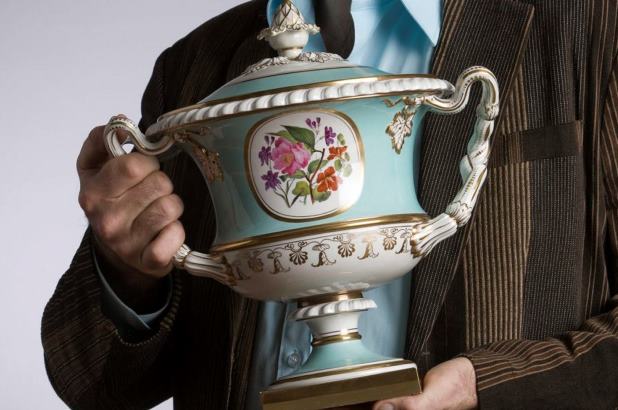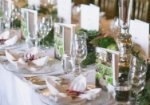This weekend is the last chance to see the beautiful exhibition The Artist & the Botanical Collector: The lost works of Lovegrove & Bäuerlen at the Museum of Sydney. It’s inspired me to write about beautiful works of botanic art in our collections, found on a magnificent dessert service.
Just blooming stunning!
Last time I wrote about my favorite gadget – grape scissors. This week I’m writing about what just might be my favorite objects from Sydney Living Museums’ collections – a stunning dessert service from the Caroline Simpson collection at Elizabeth Bay House – and the extraordinary floral decoration that it features.
Dessert services began to appear on wealthy European tables in the early 1700s, at a time when porcelain was a costly luxury. Splendid services by German manufacturer Meissen, followed by the French Sevres, were a flamboyant feature of aristocratic dining. Desserts as a distinct course were especially elaborate, they could even be served in a different room to the main courses. Richly decorated, ornamented and whimsically-shaped dishes enhanced their presentation (think of the ru-yi shaped dishes in the Macarthur dessert set I’ve chatted about previously.) Across the Channel, by the early 1800s English manufacturers such as Derby, Spode and Coalport were marketing dessert-ware to a rapidly growing middle-class market.
Especially as the Neoclassical taste grew to dominance and replaced the earlier Rococo, the flat areas of plates, dishes and comports were hand-painted with floral vignettes, mythological or even landscape scenes. The wonderful folios of flower studies by artists such as the French Pierre-Joseph Redouté, and the increasing number of scientific publications were a ready source of inspiration. The wallpaper in Vaucluse House’s drawing room, with its vignettes of roses, passionflowers and fuschia, was also inspired by these. This later untitled work by Gertrude Lovegrove – which I think is roses with a setting of nandina leaves – is the kind of work that porcelain artists had looked to:
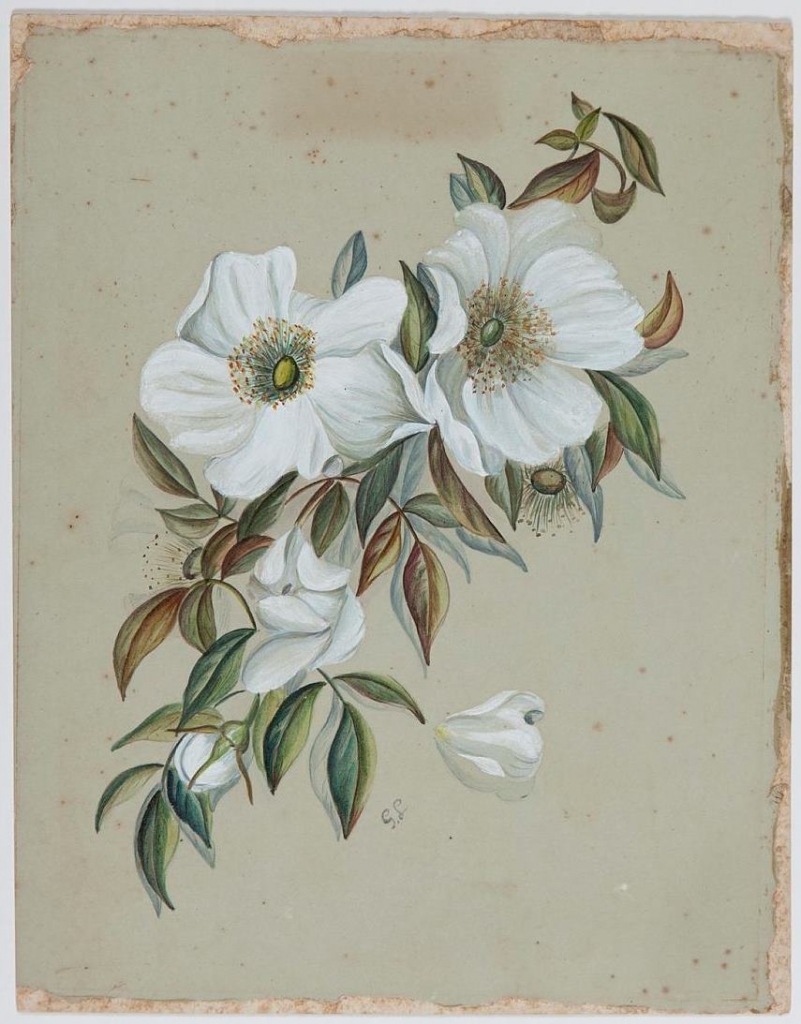
Botanical study of unnamed flower [roses and nandina leaves?] by Gertrude Lovegrove. Caroline Simpson Library & Research Collection, Sydney Living Museums
Flight Barr & Barr service
A few years back the curators at SLM were photographed with favorite objects, and I chose a cooler from a dessert service by English manufacturer Flight, Barr & Barr, from Elizabeth Bay House. The first image above is a detail from that photo (wow I looked young…). The full service was only part of a important donation in 2004, made by the children of the late Caroline Simpson OAM in memory of their mother, who was a significant collector of fine and decorative arts, furniture and Australiana.
Diverse pieces from a c1820-25 dessert service by Flight Barr & Barr. Sydney Living Museums, Caroline Simpson collection
[Joseph] Flight, [Martin] Barr & [George] Barr, until 1813 known as ‘Barr, Flight & Barr’, was one of the manufacturers operating from Worcester and produced particularly high quality porcelain until sold to Chamberlain & Co. in 1840.
Dominating the set with its beautiful, aqua-blue ground, are a pair of urn-shaped coolers, whose distinctive handles, shaped like twisted grape vines, are based on the Roman Warwick Vase, excavated from the Roman emperor Hadrian’s villa near Rome.
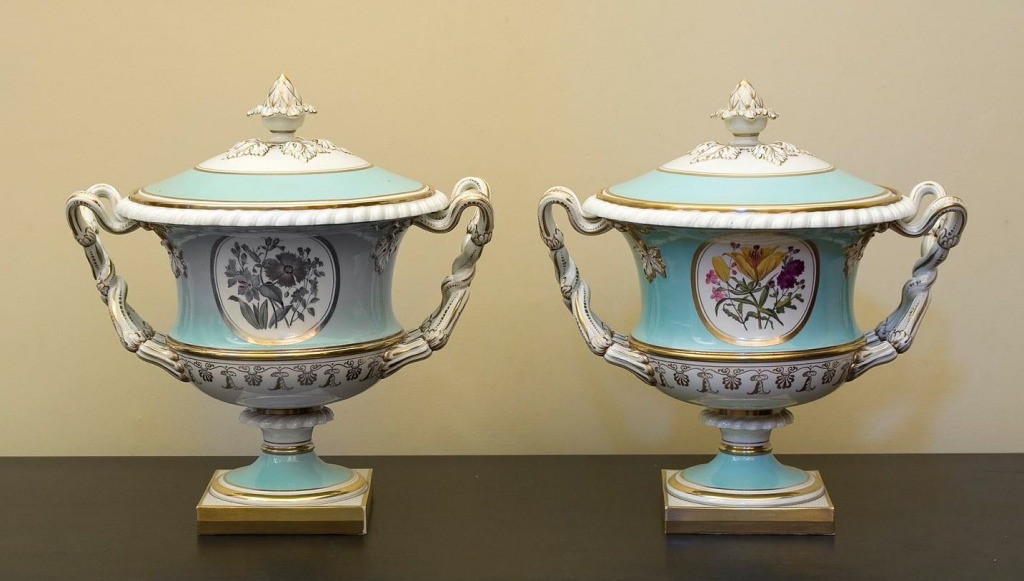
Pair of wine coolers c1820-25, by English porcelain manufacturer Flight Barr & Barr. Caroline Simpson collection, Sydney Living Museums
As you can see, one of them – oddly – never received the final colouring to its floral vignette. This colouring was all by hand, and quite often by a series of artists who specialised in a particular flower or colour, all working in a production line. Some works can be identified as being by a single artist. Inside each urn is a removable inner compartment; if you were in Britain the cavity could be filled with snow or crushed ice from an ice-house, to keep the interior nicely chilled:
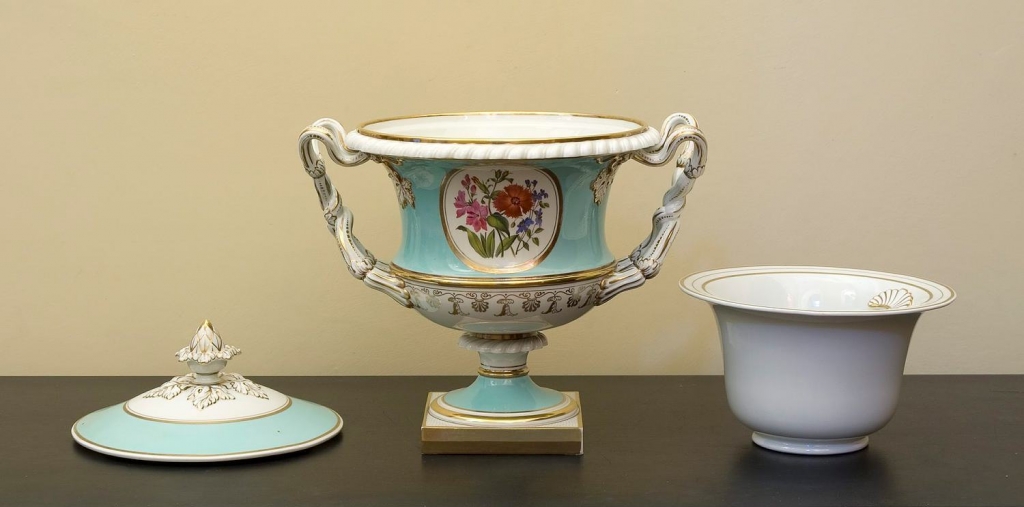
Wine cooler showing its component parts, c1820-25, by Flight Barr & Barr. Caroline Simpson collection, Sydney Living Museums
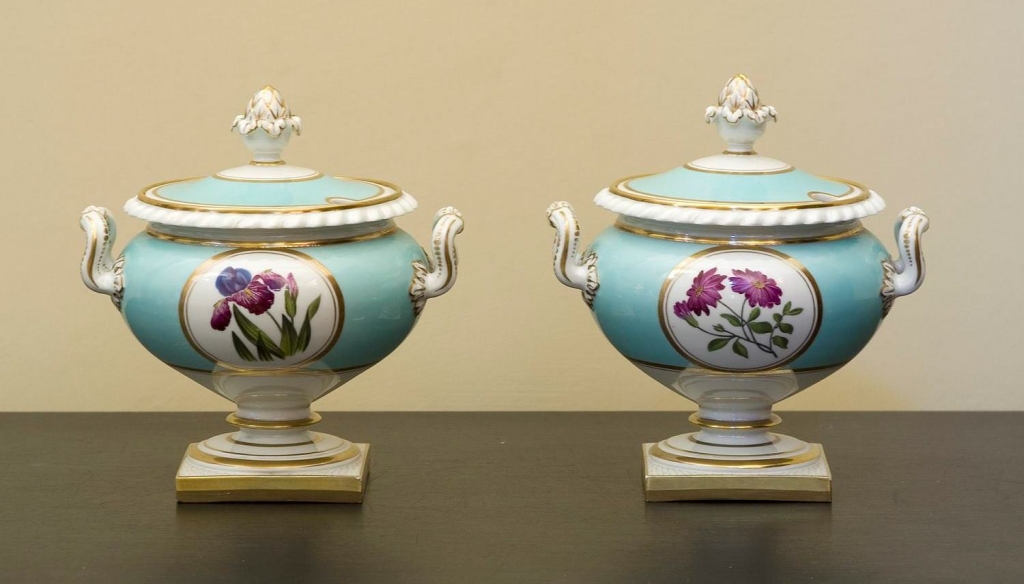
Pair of dessert tureens c1820-25, by English porcelain manufacturer Flight Barr & Barr. Caroline Simpson collection, Sydney Living Museums
Lozenge shaped dishes decorated with South African ‘Cape Bulbs’ – Watsonia and Ixia flowers, from a c1820-25, Flight Barr & Barr dessert service. Sydney Living Museums, Caroline Simpson collection
While the coolers and covered tureens feature larger vignettes, the serving and individual plates are decorated with individual flower studies. Alongside roses, anemones and larkspurs sit the new plant discoveries prized by collectors: passionflowers, fuchsias, and the ‘Cape Bulbs’ the ixias, watsonias and gladiolas. The back of each plate carries a hand-painted label. The service reflects the botanical interests of Elizabeth Bay’s creator, Alexander Macleay, and the horticultural passion he shared with his daughter Fanny, sons William Sharp and George, and nephew Sir William John Macleay:
‘Watsonia’. Flower study from a dessert plate in a Flight Barr & Barr c1820-25 dessert service. Sydney Living Museums, Caroline Simpson collection
‘Rose’. Flower study from a dessert plate in a Flight Barr & Barr c1820-25 dessert service. Sydney Living Museums, Caroline Simpson collection
‘St John’s wort’. Flower study from a dessert plate in a Flight Barr & Barr c1820-25 dessert service. Sydney Living Museums, Caroline Simpson collection
‘Single anemone’. Flower study from a dessert plate in a Flight Barr & Barr c1820-25 dessert service. Sydney Living Museums, Caroline Simpson collection
‘Tall browalia’. Flower study from a dessert plate in a Flight Barr & Barr c1820-25 dessert service. Sydney Living Museums, Caroline Simpson collection
‘Passion Flower’. Flower study from a dessert plate in a Flight Barr & Barr c1820-25 dessert service. Sydney Living Museums, Caroline Simpson collection
‘Larkspur’. Flower study from a dessert plate in a Flight Barr & Barr c1820-25 dessert service. Sydney Living Museums, Caroline Simpson collection
‘Ixia’. Flower study from a dessert plate in a Flight Barr & Barr c1820-25 dessert service. Sydney Living Museums, Caroline Simpson collection
‘Chinese Rose’ [Hibiscus Sinensis]. Flower study from a dessert plate in a Flight Barr & Barr c1820-25 dessert service. Sydney Living Museums, Caroline Simpson collection
‘Anemone’. Flower study from a dessert plate in a Flight Barr & Barr c1820-25 dessert service. Sydney Living Museums, Caroline Simpson collection
‘Larkspur’; label from a dessert dish from a Flight Barr & Barr, c1820-25 dessert service. Sydney Living Museums, Caroline Simpson collection
Rococo-a-gogo
A slightly later set, also at Elizabeth Bay House, is by the manufacturer John Alcock, and dates to around 1830-40. Its in the incoming Rococo Revival, looking inspired by the florid and curvaceous style of the mid 1700s. With the wars with France well and truly over, this French inspired style was now acceptable and manufacturers took to it with relish. These plates, with their curving and pierced edges, are painted with a vignette of flowers. The green background colour was a particularly popular choice for a dessert set. The vignette combinations are a reminder of ‘gardenesque’ planting principles: note that each flower contrasts in shape, colour and form with its neighbor, just as they would in a Victorian garden or in a vase of flowers:
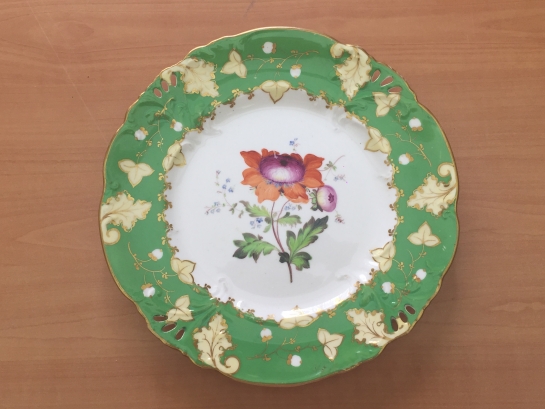
Plate from a c1830-40 dessert service by John Alcock. Elizabeth Bay House collection. Photo (c) Sydney Living Museums
Detail from a plate from a c1830-40 dessert service by John Alcock. Elizabeth Bay House collection. Photo (c) Sydney Living Museums
Last chance to see!
The Artist & the Botanical Collector: The lost works of Lovegrove & Bäuerlen features flower studies by Gertrude Lovegrove, part of an 1890s collaboration with botanical collector William Bäuerlen for an “ambitious and ultimately unsuccessful endeavour to produce a multi-part publication called The wild flowers of New South Wales.” The exhibition closes this weekend at the Museum of Sydney – see here for more details.
The Flight Bar & Barr service is not on everyday display at Elizabeth Bay House, however one of the coolers can be seen in the foyer of Sydney Living Museums’ head office on Macquarie Street, in the Mint building next door to the Hyde Park Barrack.
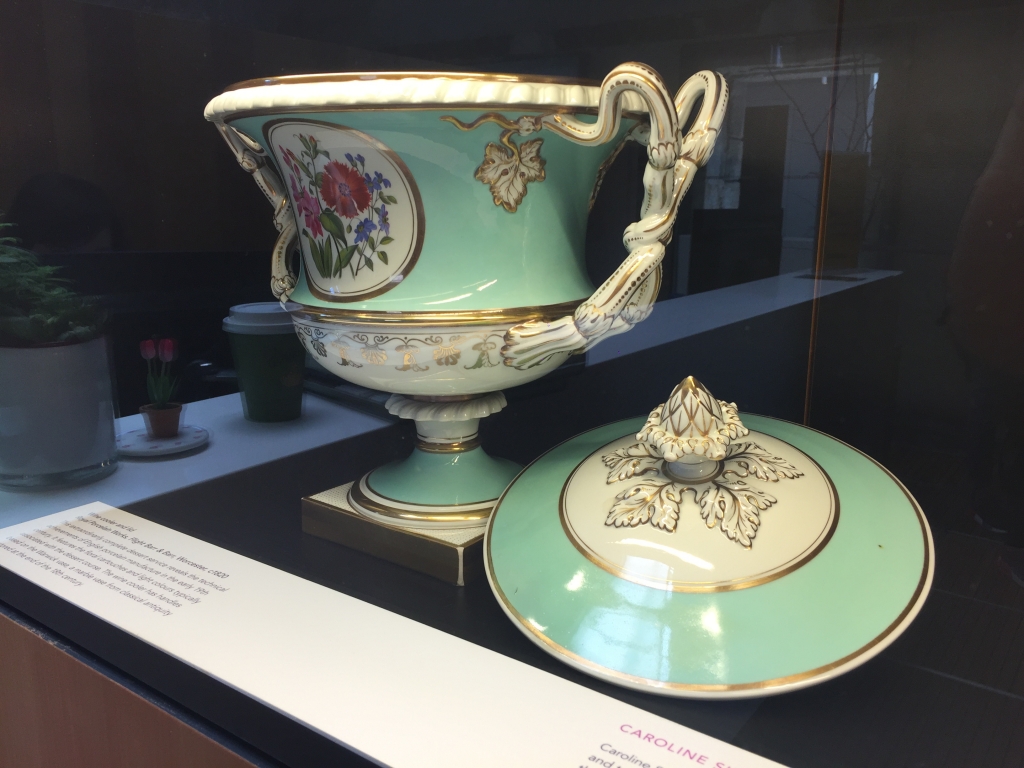
Wine cooler on display at the Mint_Photo (c) Scott Hill for Sydney Living Museums
